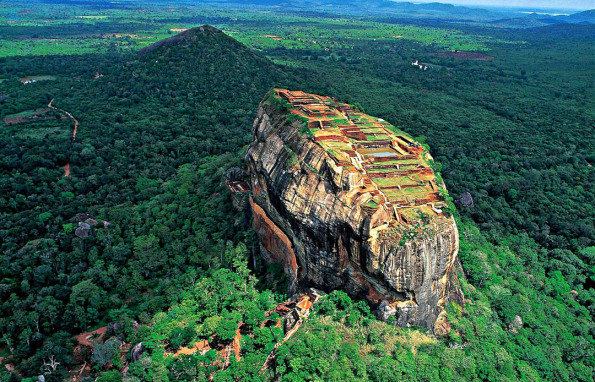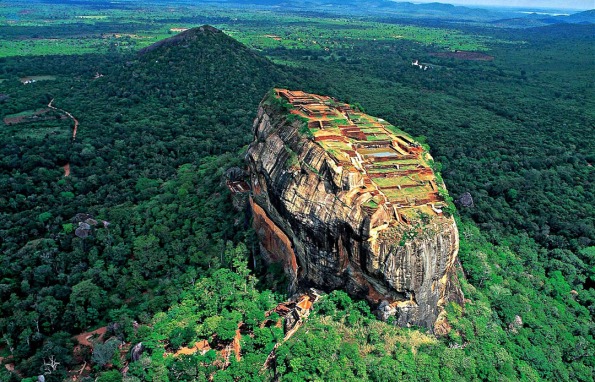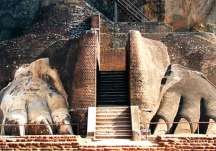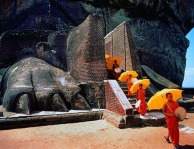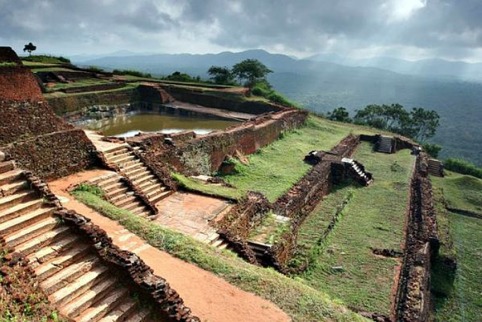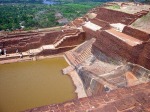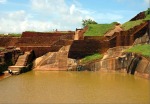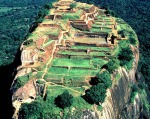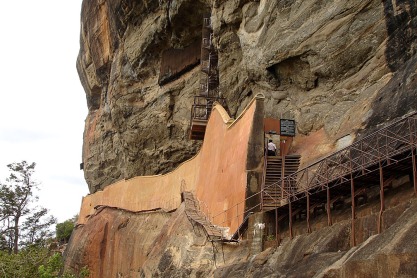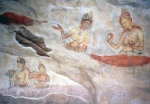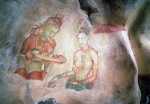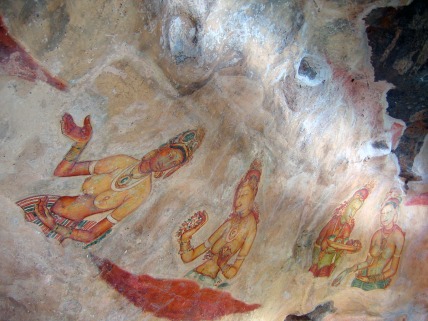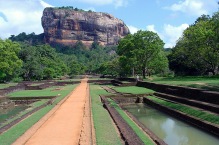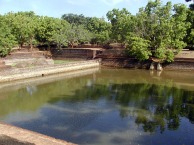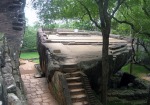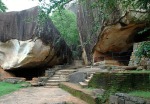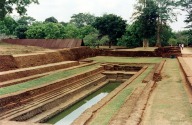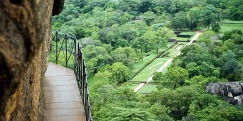Deep in the middle of Sri Lanka, a massive column of rock juts out from the green tropical forest. It reaches 660 feet tall and features frescoes, graffiti, and landscaped gardens. The rock is known as Sigiriya (see-gee-REE-yah) and holds a special place in the island’s cultural history.
It was established as the stronghold of a rogue king over 1,500 years ago, and today the Sigiriya complex stands as one of the earliest preserved examples of ancient urban planning. Ultimately the rock was unable to save its king, but it succeeded in preserving ancient Sinhalese culture.
*
Geography
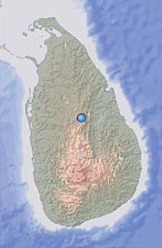 Sri Lanka lies just off the southeastern coast of India, a small island about the size of West Virginia (or a tad smaller than Austria or Scotland for European readers).
Sri Lanka lies just off the southeastern coast of India, a small island about the size of West Virginia (or a tad smaller than Austria or Scotland for European readers).
It is known as “the Pearl of the Indian Ocean,” a tribute to the island’s natural beauty, people – even its shape.
Located in the Matale District of the Central Province (map), the column of rock is somewhat central to the country. Historians believe the region has been inhabited since the 3rd century BCE, making the site one of historical and archaeological significance to Sri Lanka.
The rock is known as Sīhāgiri, meaning “Lion Rock,” a nod to the giant animal carved from stone which greeted visitors at the entrance.
The site was a temporary capital from 477-495 CE when Sri Lanka was under the rule of King Kashyapa.
*
Kashyapa’s Reign
In 476 CE, King Dhatusena ruled over Sri Lanka. One of his illegitimate sons, Kashyapa, wanted the throne – but knew his full-blood brother Moggallana was next in line. Determined to stake his claim, Kashyapa schemed with the commander of the army to overthrow Dhatusena.
Lore says Kashyapa showed little mercy on his father, walling him up while still alive. But the message was clear, and it sent Moggallana fleeing to Southern India to escape a similar fate. With his dad and brother out of the picture, Kashyapa crowned himself king in 477 CE.
One of his first orders of business was to relocate the royal seat to Sigiriya from the traditional capital of Anuradhapura. It was ambitious and probably somewhat rooted in fear; King Kashyapa had killed the king and driven away the rightful heir to the throne.
In the interest of self-preservation, King Kashyapa immediately began work on his stone fortress.
*
The Lion Rock
King Kashyapa chose Sigiriya because he believed it would give his forces a strategic advantage if attacked. Its elevated position was an advantage to the defensive stronghold, offering fantastic 360-degree views. Plans to build a city quickly unfolded and after several years, the Sigiriya complex had become a bustling center for the new King.
The igneous rock earned its name from the enormous lion which greeted visitors halfway up the rock on a small plateau. A gateway to the Sigiriya, a lion carved from rock served to both welcome visitors and warn enemies.
(click to enlarge)
The lion paws are all that remain of the gate today
Sigiriya was both a palace and a fortress; the overall complex featured five gates and measured just under two miles wide (3 km) by just over a half-mile long (1 km). The site plan consisted of a citadel, an upper palace on the top of the rock, and lower palaces at ground level.
The King also constructed lavish gardens throughout, and for protection a moat with ramparts surrounded the complex.
The top of the rock was home to a beautiful landscaped gardens and the upper palace, today the oldest surviving palace in Sri Lanka. The upper gardens employed an advanced irrigation system which utilized surface and subsurface hydraulic systems.
Cisterns cut from the rock still function today.
*
The Culture
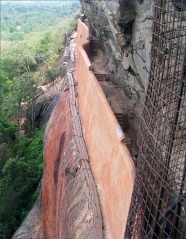 Frescoes adorn the western side of the rock, along with the mirror wall, a brick face covered in a highly-polished white plaster (pictured at left). When new, the wall was said to be able to produce reflections.
Frescoes adorn the western side of the rock, along with the mirror wall, a brick face covered in a highly-polished white plaster (pictured at left). When new, the wall was said to be able to produce reflections.
Over time the Mirror Wall became a graffiti board, covered in verses scribbled by visitors. Known as “Sigiri Graffiti,” some of the messages date to the 8th century CE.
One inscription believed to be over 500 years old read:
“බුදල්මි. සියොවැ ආමි. සිගිරි බැලිමි. බැලු බැලු බොහො දනා ගී ලීලුයෙන් නොලීමි.”
Rough translation: “I am Budal. I came alone to see Sigiriya. Since all the others wrote poems, I did not!“
The message isn’t revelatory but if offers an insight to centuries-old human thought. Budal’s comment is not far off from what a visitor might offer today.
The tradition of additions by visitors forced officials to “close” the wall to new inscribing. To preserve the existing ancient graffiti, the wall is being treated to an on-going protective restoration.
A pocket in the Cobra Hood Cave is home to beautiful paintings of Sinhalese maidens performing various tasks. The maidens have escaped exposure to the elements for more than a millennium in the rock’s natural cavity.
The paintings are believed to be over 1,500 years old, and while the true significance is unknown, there are multiple theories. Some believe the maidens display religious rituals while others believe the images immortalize the many wives of the king.
The Maidens of Cobra Hood Cave at Sigiriya
*
The Gardens
One of the most breathtaking features of Sigiriya was the gardens, which consisted of three distinct components: The water gardens, the cave and boulder gardens, and the terraced gardens.
The water gardens occupied the western part of the Sigiriya complex and were further divided into three sub-sections. The first was a large plot surrounded by water connected to the main complex via four channels.
The second consisted of a path flanked by two long, narrow pools supplied water by nearby streams. Circular limestone fountains were fed by an underground aqueduct system. Built to last, the Sinhalese fountains still produce terrific displays today – especially during the rainy season.
The second garden also featured small ponds with four man-made islands on either side of the narrow pools. Two of the islets boasted ornate palaces which served as guest quarters for visiting dignitaries.
Just east of the second lies the third water garden, easily identifiable by the octagonal pool with a citadel on the northeastern corner.
Visitors to Sigiriya pass through the winding paths of the boulder gardens en route to the rock-top palace. Located just west of Sigiriya and geographically separating the rock from the western water gardens, the boulder gardens had decorative pavilions constructed on each rock.
As impressive as the water and boulder gardens were, the terraced gardens was arguably the most impressive. At the base of the Sigiriya the gentle natural incline was terraced and planted.
A limestone staircase divides the terraced gardens and guides visitors to a covered path which eventually leads to the main lion gate.
Symmetrical design was a staple of the gardens, which were connected to the outer moats on the west and the man-made lake (“Sigiriya Tank”) to the southeast. Additionally, an intricate underground conduit network interlinked the various pools and connected them to the lake.
Today the landscaped gardens of Sigiriya are the oldest surviving in Asia and among the oldest in the world.
*
The Rock Palace
The crown jewel of Sigiriya today is the king’s palace complex at the summit of the rock. Nearly a miniature city in its own right, it consists of a palace, fortified rock fortress, an organized system of cisterns, and various rock carvings and sculptures.
A massive rock wall protects Sigiriya from the east, although details are forthcoming as additional excavation of the eastern quarter is on-going and not yet complete.
*
Fall of The King
Moggallana, the rightful heir to King Dhatusena’s throne, would later defeat Kashyapa in 495 CE. Legend tells of the battle, in which Moggallana returns to Sri Lanka with forces to overthrow Kashyapa. During the battle, Kashyapa’s elephant balked at an obstruction and turned aside. The king’s troops mistook the movement as a retreat. The troops scattered and chaos ensued.
One version of Kashyapa’s demise is as flamboyant as the King himself: With no troops left for support and death imminent, Kashyapa drew his dagger, slashed his own throat, and sheathed the blade before collapsing dead.
After the battle King Moggallana moved the capital back to its historic seat in Anuradhapura.
*
After Kashyapa
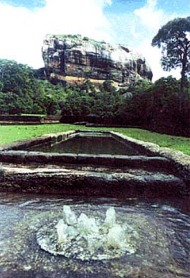 The gardens and palace at Sigiriya were abandoned, but later assumed by a Buddhist monastery which would occupy the land until the 14th century.
The gardens and palace at Sigiriya were abandoned, but later assumed by a Buddhist monastery which would occupy the land until the 14th century.
There are no records of the activity at Sigiriya between the 14th and 16th centuries, but by the 17th century it was used as an outpost for the Kingdom of Kandy independent monarchy.
Western civilization re-discovered Sigiriya in 1831 when British army Major Jonathan Forbes of the 78th Highlanders discovered the bush-covered summit of Sigiriya on a horseback trip across the island.
In the 1890s archaeologist H.C.P. Bell spent some time at Sigiriya, overseeing a small dig and research operation.
[Jump to vintage Sigiriya picture gallery]
It would be another twenty years until the natural rock formation would return to the public eye; British explorer John Still’s visit to Sigiriya in 1907 sparked international discussion and renewed interest in the Sri Lanka treasure.
Full-scale archaeological work would not begin until 1982, when government-fundedCultural Triangle Project focused its attention on the ancient city. It was during this time historians learned of the Lion’s presence at the gate to Sigiriya, its head having collapsed long ago.
*
Legacy
The brief period as a seat of power and its remote location have conspired to push Sigiriya to history’s periphery, but the contributions by the ancient Sinhalese culture responsible make it no less significant.
Today the complex stands as one of the best-preserved examples of ancient urban planning. The gardens are the oldest surviving in Asia. Sigiriya is the most-visited historic site in Sri Lanka and is one of only 7 UNESCO World Heritage Sites in the country.
Sri Lanka proudly bills the ancient city as “the Eighth Wonder of the World,” and considering the advanced irrigation systems still bring water to the landscaped gardens over 1,500 years later, it has the résumé to be in the conversation.
*
Conclusion
Many of the details we have about Sigiriya are educated estimations based on results from archaeological digs, rough translations, known historic events, and sometimes simply lore. For example, we don’t know for certain whether Kashyapa began construction on Sigiriya or if he merely completed his father’s work.
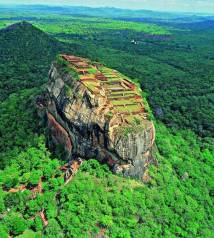 We don’t know whether Sigiriya was a fortified stronghold, a place of meditation and worship, or a pleasure palace for a playboy king. We do know Kashyapa overthrew Dhatusena, finished building and later occupied Sigiriya, and ultimately perished during battle at the site.
We don’t know whether Sigiriya was a fortified stronghold, a place of meditation and worship, or a pleasure palace for a playboy king. We do know Kashyapa overthrew Dhatusena, finished building and later occupied Sigiriya, and ultimately perished during battle at the site.
King Kashyapa was a very small part of history in Sri Lanka, but the permanence of his rock palace is a testament to the brilliance of early Sinhalese engineering and design. While the Dark Ages plunged Europe into a dearth of culture, Sri Lanka was flourishing.
If there is a lesson we can learn from Kashyapa’s story, perhaps it is that no amount of fortification can defend against unlawful claims to the throne.
